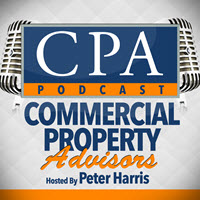
Do you want to invest in a passive commercial real estate investment where there are no landlord responsibilities, no management duties, and no evictions? Too good to be true? Well it is not. It is like getting monthly mailbox money or clipping coupons. That is what we call a triple net lease investment. In this blog I will tell you precisely how a triple net lease works when investing in a commercial real estate.
What is a Triple Net Lease?
Starbucks is a good illustration of a triple net lease. Someone owns the Starbucks, but Starbucks doesn’t own the building, there is an individual who owns it. If you were the owner, Starbucks would pay you a rental payment every month. Let’s say they pay $20,000 a month. As a triple net lease, Starbucks will pay for all the expenses for the next 15 years. That is the best thing about a triple net lease. Starbucks will be paying for all of the building repairs, the parking lots, windows, roof, electrical, for your insurance, your taxes and much more. Everything is paid for by them.
You get a $20,000 a month lease payment out of Starbucks. Then you use this cash to pay the mortgage if there’s one, and everything left over is your cashflow. That’s what we call a triple net lease, where Starbucks does not own the building, they’re just the tenant, plus they pay you a rental payment and pay for all the expenses. You simply pay your mortgage and the rest if cashflow. You don’t have any landlord duties, no management responsibilities, and no evictions.
Second Example
When you go to a large supermarket chain, that supermarket probably doesn’t own the building, they’re only a tenant that pays the owner of the building a triple net lease payment. The supermarket pays all the insurances, taxes, repairs, and other expenditures. The same is true for most leading restaurant chains, banks, and single buildings. They’re not the owners of these buildings. There is a landlord who owns the building and the company leases from them.
Advantages of Triple Net Leases
1. As I mentioned previously, one of the great benefits of the triple net lease is the rental will last 15 to 20 years, and included in that lease, every five years or so will be rent increases. So, over these 15 to 20 years you’re going to get rent increases that go up incrementally, and they’re fixed within the lease, so that’s an advantage.
2. Another benefit is, there will be no landlord duties because your tenant pays for all of the costs. They cover the taxes, insurance, repairs and all building maintenance. There is nothing for the landlord to do besides collect your check, pay your mortgage, and experience cash flow. The best part is that this kind of cash flow is steady because of those three things; the long-term lease, no landlord obligations, and the renter pays all the utilities and expenses. Plus, there’s potential for rent increases every five years.
3. Finally, you have a low turnover because they are committed for such a long time. It is not like apartment buildings in which the tenants last on average a year to 18 months. With a triple net lease, the tenants will stay no less than 15-20 years on most occasions.
The Ultimate Goal
For some of you, the triple net lease might be the ultimate goal. You may have invested for 20 years in your single-family houses or apartment buildings and worked hard to get where you are. Now you are successful, but still involved in the daily maintenance of these rental properties. You think maybe you ought to pull back a little, retire possibly. A triple net lease investment will be ideal for you because of all of these advantages.
Disadvantages of Triple Net Leases
What do you do when the lease ends?
However, there are disadvantages and drawbacks to each of these benefits. Firstly, there is a risk once the lease is finished. Let’s say you owned a triple net lease property occupied by four tenants; a large grocery chain store, a hair salon, a shoe store, and a pharmacy. The grocery chain store lease ends after 15 years and they choose to relocate. That leaves you only collecting three out four rents, and your biggest paying tenant is gone, leaving a big, dark vacant building. What should you do now? That is a risk.
Or you may have a triple net lease on a single-tenant bank, and the bank decides to move out. You are currently 100% vacant, which is a big problem. So, the risk of doing a triple net lease investment would be; what occurs when the lease ends? A lot of planning can help to overcome and mitigate that threat, but it’s still there.
High Capital Cost
The next drawback is the high capital cost when the lease ends. Let’s say you own that bank building, and the bank lease expires, so they move out. Now you need to get everything prepared in the building to get a new bank or a totally different company. And guess what? Those costs are yours. You are paying hundreds of thousands of dollars to get that building prepared for the next tenant.
There is also a limited upside to a long-term lease when the market gets hot because it has fixed increases. If the market gets hot there’s nothing you can do. You can’t take advantage of it because you you’re held to the conditions of your lease. You can’t break the lease and increase the rents, so there’s a limit to this advantage.
All Triple Net Leases are Not Created Equally
Would you rather rent your building to Starbucks or to Joe’s Coffee who just has one store? Obviously, you prefer to lease to Starbucks because if they shut the shop after five years, they’ll write you a check for the remaining years on the lease. If Joe’s Coffee go out of business, that is it, you’re left with a vacant building. Even though both are triple net leases, a Starbucks will guarantee virtually all their rent remaining, whereas a mom and pop shop cannot.
Who Should Do a Triple Net Lease?
In my opinion, it’s the retiree looking for stable money to live off of. I have a friend who’s owned her apartment buildings since we were in our twenties, that she inherited from her dad. She’s a wonderful person who has an excellent job, but last week she asked me, “Peter, what can I do once I turn 70, I do not want to continue to maintain apartments, they are too much work”
She’s the ideal person for a triple net lease, since now she is prepared to just sort of pack it in, do something that’s extremely passive so she can enjoy family and grandkids. I explained to her the advantages and disadvantages and she understood them. In the upcoming years she is going to think about the triple net lease as a retiree option.
Example 2
Another type of person that should invest in a triple net lease property is someone that owns a five cap rate property. If that is you, then you’re going to sell your five cap rate property and buy an 8 percent triple net lease property out of state. If you’re in a high price area like I am in California, you sell your high cost, low cap property with all the equity. This may not produce a lot of cashflow since the purchase price is so high, but you’re going to maximize your equity by buying an 8 percent triple net lease property in the Midwest or Southwest. You’re going to purchase a strip mall, or a bank building, or any triple net rental buildings out of state to make the most of the equity. This is ideal for a person that has a high price property and a lot of equity; who maximize their equity with cashflow while kicking back.
Example 3
The third type of person is, when you are ready to park your money. If you have received a large inheritance or are fortunate enough to be a trust fund baby and you’re not sure where to invest the money, but you need to put it somewhere to begin earning 4%, to 5%, to 6%, you’d put it into a triple net lease investment for the next 15 to 20 years. Or, sometimes global investors will take their money out of a very unstable overseas country, and they bring it into a more stable environment, like the United States, and invest it into a 15 to 20 year triple net lease property. That happens a whole lot and this country.



